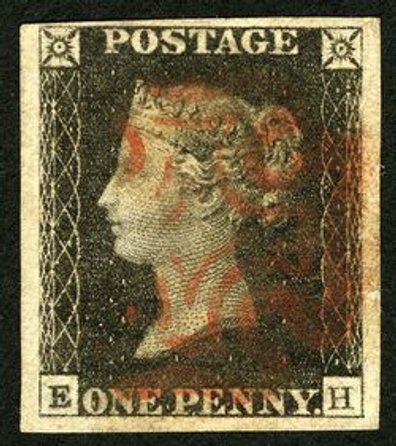This information comes from Postal History, a New Zealnd website created by Eunice and Ron Shanahan. My thanks to them for giving their kind permission to use the material. — Marjorie Bloy

he cost of posting a letter had risen steadily over the years. In 1680, a merchant named William Dockwra organised the London Penny Post, which delivered mail anywhere in London for a penny. He also introduced the practice of postmarking letters to indicate when and where they had been posted. However, the system became so successful that the government took control of the operation in 1682 and absorbed it into the Post Office: from then on the charges gradually increased. Successive Governments had used the profits from the postal service as revenue. In particular, the money was being used to finance the almost continuous wars with France. Each time more money was needed, the cost of postage was increased. This led to increasing public dissatisfaction and criticism of the high postage rates. To send a letter from Edinburgh to London, could cost as much as a day's wages: ¾d. As a result of the public complaints, a Committee of Enquiry was set up in 1835.

Rowland Hill by Edward Onslow Ford. Click on thumbnail for larger picture.
Two years later, Rowland Hill published a pamphlet entitled 'POST OFFICE REFORM' . In this, he proposed a uniform postage rate of 1d, — One Penny — which would lead to an increase in correspondence and the virtual abolition of attempts to evade the postage. At this time, an indoor servant would be earning twenty-five pounds a year, that is about ten shillings a week.
Rowland Hill argued that distance had little bearing on the cost of conveying a letter. He pointed out that a very important factor in the cost was that the letters which were not pre-paid had to be personally delivered to collect the postage. The letter carriers may sometimes have had to make five or six calls until they could deliver the letter and collect the money - which was a waste of time.
Sometimes the addressee would refuse to accept the letter. Because of the high cost, many frauds were common. One was that the writer would put a code marking on the outside of the letter, so that when it was delivered, the addressee would see the code mark, understand the message from the sender, and so refuse delivery.
Rowland Hill suggested that by using a specially designed adhesive label to pre-pay the postage, huge labour costs would be saved. Later in 1837 the Select Committee of Postage was set up and by one vote only, they recommended that Parliament adopt Hill's scheme. However, postage was not reduced to One Penny at once, but from 5 December 1839, a General Fourpenny Rate was set up for letters up to half an ounce in weight. Letters up to one ounce were charged 8d and each additional ounce up to 16 ounces cost 8d. The Fourpenny Post lasted only from 5 December 1839 to 9 January 1840 and markings were applied mostly by handwriting.
The Uniform Penny Post came into force on 10 January 1840, and Rowland Hill was proved right. On the first day of the Penny Post 112,000 letters were posted, more than three times the number posted on that day the previous year. However, the stamps and the printed envelopes and covers were not available until 6 May 1840.
 In 1839 there were
76 million letters posted in the United Kingdom. In 1840 after the introduction
of the Penny Post there were 168 million and ten years later this had doubled
to an incredible 347 million letters.
In 1839 there were
76 million letters posted in the United Kingdom. In 1840 after the introduction
of the Penny Post there were 168 million and ten years later this had doubled
to an incredible 347 million letters.
The production of the huge numbers of the adhesive labels required was possible only because of the developments in the British printing and machinery industry. At this time Britain was leading the world in industry, and was soon to be known as the Workshop of the World. The idea of the gummed label was so simple, and the design so attractive, that it was copied by postal administrations all around the world. In Britain the whole concept was generally accepted so that in 1856 it became compulsory to pre-pay postage.
The inventor of the Penny Black, Rowland Hill, was knighted by Queen Victoria for 'services to the Nation'.
Related Material
- The Perkins D cylinder Printing Press used to print the first stamps
- Letters from the Past (Postal history and a Collection of Victorian and earlier letters)
- A resource about the Penny Black stamp (blog.postofficeshop.co.uk — UK site)
Created 30 December 2013
Last modified 10 January 2025